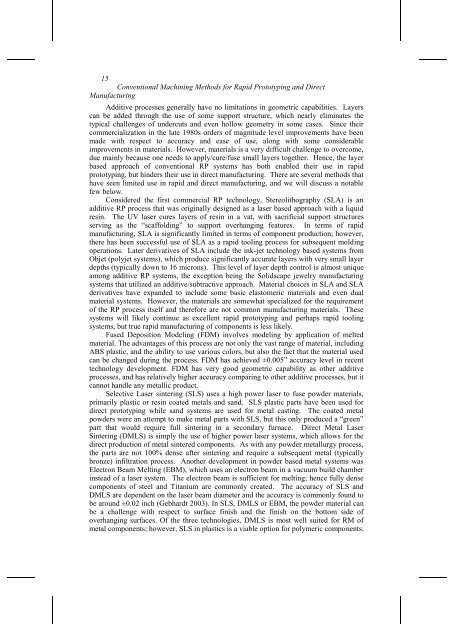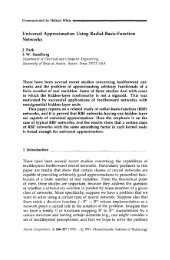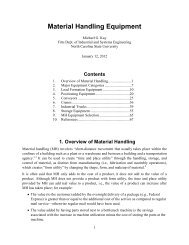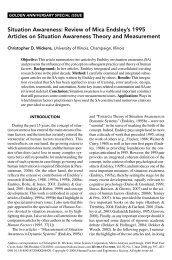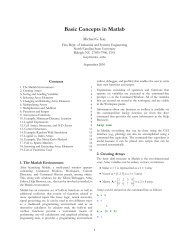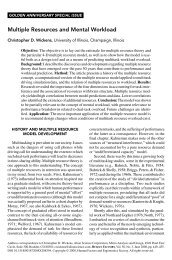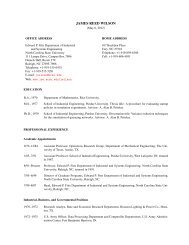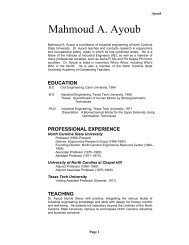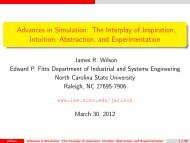Conventional Machining Methods for Rapid Prototyping
Conventional Machining Methods for Rapid Prototyping
Conventional Machining Methods for Rapid Prototyping
Create successful ePaper yourself
Turn your PDF publications into a flip-book with our unique Google optimized e-Paper software.
15<br />
<strong>Conventional</strong> <strong>Machining</strong> <strong>Methods</strong> <strong>for</strong> <strong>Rapid</strong> <strong>Prototyping</strong> and Direct<br />
Manufacturing<br />
Additive processes generally have no limitations in geometric capabilities. Layers<br />
can be added through the use of some support structure, which nearly eliminates the<br />
typical challenges of undercuts and even hollow geometry in some cases. Since their<br />
commercialization in the late 1980s orders of magnitude level improvements have been<br />
made with respect to accuracy and ease of use, along with some considerable<br />
improvements in materials. However, materials is a very difficult challenge to overcome,<br />
due mainly because one needs to apply/cure/fuse small layers together. Hence, the layer<br />
based approach of conventional RP systems has both enabled their use in rapid<br />
prototyping, but hinders their use in direct manufacturing. There are several methods that<br />
have seen limited use in rapid and direct manufacturing, and we will discuss a notable<br />
few below.<br />
Considered the first commercial RP technology, Stereolithography (SLA) is an<br />
additive RP process that was originally designed as a laser based approach with a liquid<br />
resin. The UV laser cures layers of resin in a vat, with sacrificial support structures<br />
serving as the “scaffolding” to support overhanging features. In terms of rapid<br />
manufacturing, SLA is significantly limited in terms of component production; however,<br />
there has been successful use of SLA as a rapid tooling process <strong>for</strong> subsequent molding<br />
operations. Later derivatives of SLA include the ink-jet technology based systems from<br />
Objet (polyjet systems), which produce significantly accurate layers with very small layer<br />
depths (typically down to 16 microns). This level of layer depth control is almost unique<br />
among additive RP systems, the exception being the Solidscape jewelry manufacturing<br />
systems that utilized an additive/subtractive approach. Material choices in SLA and SLA<br />
derivatives have expanded to include some basic elastomeric materials and even dual<br />
material systems. However, the materials are somewhat specialized <strong>for</strong> the requirement<br />
of the RP process itself and there<strong>for</strong>e are not common manufacturing materials. These<br />
systems will likely continue as excellent rapid prototyping and perhaps rapid tooling<br />
systems, but true rapid manufacturing of components is less likely.<br />
Fused Deposition Modeling (FDM) involves modeling by application of melted<br />
material. The advantages of this process are not only the vast range of material, including<br />
ABS plastic, and the ability to use various colors, but also the fact that the material used<br />
can be changed during the process. FDM has achieved ±0.005” accuracy level in recent<br />
technology development. FDM has very good geometric capability as other additive<br />
processes, and has relatively higher accuracy comparing to other additive processes, but it<br />
cannot handle any metallic product.<br />
Selective Laser sintering (SLS) uses a high power laser to fuse powder materials,<br />
primarily plastic or resin coated metals and sand. SLS plastic parts have been used <strong>for</strong><br />
direct prototyping while sand systems are used <strong>for</strong> metal casting. The coated metal<br />
powders were an attempt to make metal parts with SLS, but this only produced a “green”<br />
part that would require full sintering in a secondary furnace. Direct Metal Laser<br />
Sintering (DMLS) is simply the use of higher power laser systems, which allows <strong>for</strong> the<br />
direct production of metal sintered components. As with any powder metallurgy process,<br />
the parts are not 100% dense after sintering and require a subsequent metal (typically<br />
bronze) infiltration process. Another development in powder based metal systems was<br />
Electron Beam Melting (EBM), which uses an electron beam in a vacuum build chamber<br />
instead of a laser system. The electron beam is sufficient <strong>for</strong> melting; hence fully dense<br />
components of steel and Titanium are commonly created. The accuracy of SLS and<br />
DMLS are dependent on the laser beam diameter and the accuracy is commonly found to<br />
be around ±0.02 inch (Gebhardt 2003). In SLS, DMLS or EBM, the powder material can<br />
be a challenge with respect to surface finish and the finish on the bottom side of<br />
overhanging surfaces. Of the three technologies, DMLS is most well suited <strong>for</strong> RM of<br />
metal components; however, SLS in plastics is a viable option <strong>for</strong> polymeric components.


